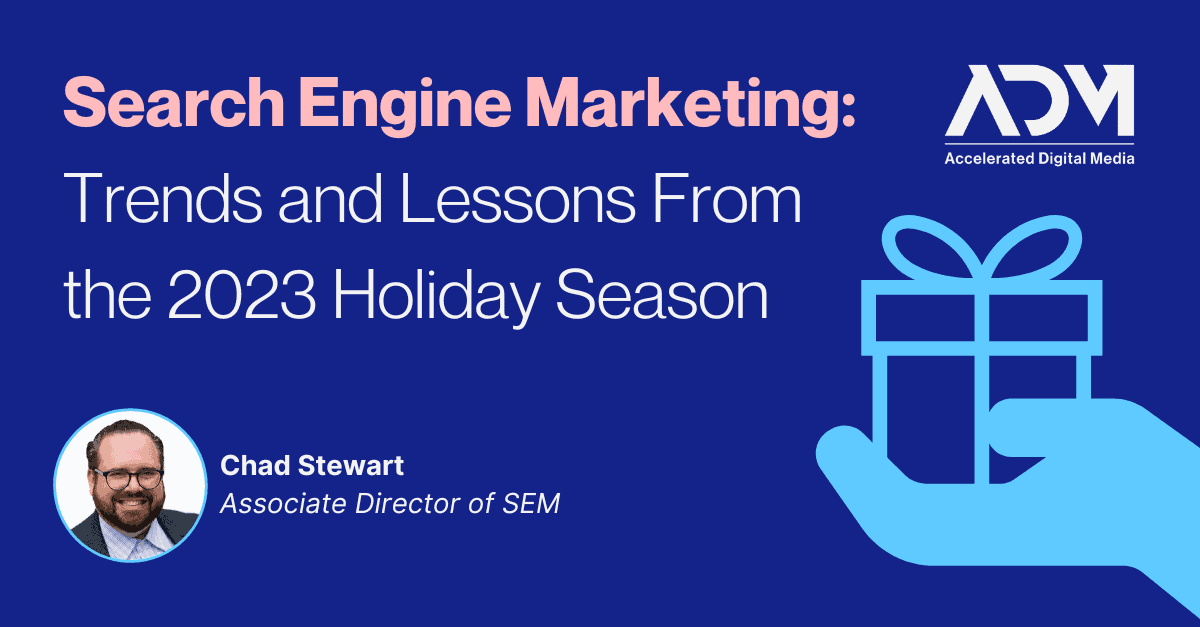The holiday season is always a huge driver of sales and revenue for eCommerce marketers—but it can also be a time to learn lessons about not only your brand’s appeal, but how the online eCommerce market is trending. This year was no different. Now that the dust has settled on the 2023 holiday season, it’s time to look at what clients and techniques performed best, and what it means for digital marketing in 2024 leading up to the next holiday season.
Our social team already dove into this topic, so it’s time for our SEM department to reflect. Here are the main trends and lessons we learned for paid search holiday marketing this year.
Discounts and Promotions Were a Major Theme
A major theme that ADM observed across all channels this holiday season was the importance of discounts and promotions. They were a substantial trend when we wrote our paid social version of this article, and our SEM team was quick to notice the role they played during this holiday season as well.
Deals were more important this year than last year for many ADM clients. Clients who embraced aggressive promotions and took advantage of all the ways Google lets you advertise them—like strikethrough pricing—reaped the benefits over brands that did not.One of our clients that committed to a large discount and began advertising it early in the holiday shopping season saw their paid search purchases increase 82% year-over-year for November, with a revenue increase of 79%. It was the year of the discount, and it may remain that way even though we’re now clear of the holidays.
Cyber Monday and Black Friday Have Merged Into One
Another trend that ADM has observed evolving with each passing year is that Black Friday and Cyber Monday are really starting to merge into a singular “major deals weekend.” Fewer and fewer people seem to be braving the stores on Black Friday. Since most clients have deals both online and in stores, there’s less of a need for foot traffic.
As shoppers increasingly take their Black Friday business online, paid ads play a bigger role in driving revenue online all weekend long. Pairing this with the previous point about promotions, more clients are opting for longer sales periods that extend their Black Friday offers days, or even weeks, after that weekend has passed. While Black Friday still unofficially kicks off the holiday sale season, it no longer lasts just 24 hours, which benefits consumers and can contribute to brands’ long-term seasonal success.
Brand Equity/Loyalty Might Be Losing Meaning
A big lesson ADM observed in the 2023 holiday season was that “brand equity” might not be what it once was. This is less of an issue for niche clients that are able to build loyal audiences because their products solve specific problems that their competitors can’t. But for more “generalist” brands, it’s harder to assume that the same people who have always ordered their products will continue to do so.
The cannibalization of in-store shopping by digital might have something to do with that. Now when searching for an item, users are simply exposed to dozens of competing options through Google Shopping ads and other digital marketing mediums. Meanwhile, a brand experience for something like apparel may have once included going to a store, interacting with employees, and trying on different clothes. Now, the brand experience is an appealing ad, a good site, an online checkout, and pleasantries like whether the brand charges for shipping and how quickly your stuff comes.
The takeaway is that brands shouldn’t rest on their laurels, but instead be focused on continually making their marketing more competitive and ensuring their user experience and payment/shipping options aren’t costing them business.
Paid Search Is Honing In On Distinct Shopping Windows
Another trend that echoed our social team’s observations was that the holiday shopping window just keeps expanding, in both directions. While it’s not a new phenomenon, it is increasingly forcing brands to look at holiday shoppers in distinct time-based buckets, rather than as a mass audience.
Users usually split into two buckets: early shoppers and the last-minute type. Early shoppers may start Christmas shopping at the beginning of November, which is why brands have adapted by tiering their sales at the start of the month instead of only beginning their push near Black Friday.
Brands also include language on their shopping ads like “ships by Christmas” or “arrives by Christmas cut off date” to ensure those who have procrastinated know exactly when they need to order by. ADM observed stable performance up to these dates in most accounts, even after promotion expirations. Planning for these two different populations has been critical in long-term holiday success.
Performance Max is the Best Option in Face of High CPCs
Across ADM’s eCommerce portfolio this holiday season, Performance Max campaigns continued to stand out as the strongest campaign tool Google Ads had to offer. While these campaigns are typically effective (especially when paired with great promotions), their impact was particularly pronounced in light of high cost-per-clicks from non-branded terms.
Non-brand search has become untenable for many brands because CPCs have risen so much over time. Meanwhile, Performance Max CPCs are cheaper and typically convert at the same rate or better, so they allow eCommerce brands to offset the challenges of an increasingly-competitive holiday season without losing revenue.
For more on using Performance Max effectively, we’ve written quite a few blogs on the subject. Check back for our upcoming eBook on best practices for these campaigns. And if you’re looking to take your digital marketing strategy in a new direction for 2024 and beyond, don’t hesitate to reach out to ADM today.




